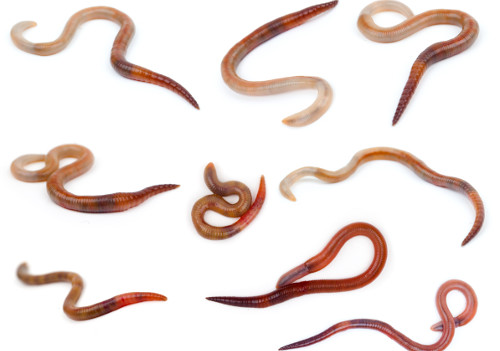With the last decade’s surge in green living, folks are looking for more and more ways to minimize their footprint on the Earth and maintain a healthy ecosystem both at home and in the wider world. Worm composting, or vermicomposting, has risen magnificently to the occasion, offering a no-fuss method for producing beautiful black soil using nothing more than a plastic bin, kitchen scraps and nature’s garbage disposal, the red wriggler. We’re here to answer all your questions so you can get started right away.
Why Should I Compost?
Composting reduces your impact on the environment, keeping organic scraps out of landfill and instead turning them into rich, nutritious, valuable “black gold” that you can use in the garden or in houseplants. However, you don’t need a yard for this form of composting … you can do it even inside apartments or condos that lack outdoor spaces. Plus, it’s a great activity to do with kids!
How Much Waste Do I Produce Per Week?
It’s important to figure out how much compostable waste you produce each week so that you’ll know how many worms you need. You can give worms almost any fruit or vegetable, with a few exceptions including citrus, potatoes, onions, garlic and ginger. Stay away from meat, dairy and bread, which can attract rodents to the bin. You can also feed your worms paper and cardboard scraps.
In order to measure the compostable waste that you produce in a week, you are going to need a scale of some sort. This is easiest to do with a simple kitchen scale, but if you do not have a kitchen scale, a bucket and a bathroom scale can be used as well. If you are using a kitchen scale, simply weigh an empty container at the beginning of the week, and then fill that container with the week’s waste. Subtract the smaller number from the larger number and you are left with the weight of compostable waste produced per week. Congratulations!
Bucket + Bathroom Scale Method
If you need to use the bucket + bathroom scale method, you are going to have a couple more steps:
- Start by measuring a large bucket using a regular bathroom scale. Stand on the scale first with the bucket, then without, then subtract the second, smaller number from the first to find the weight of the bucket.
- Collect any compostable scraps in the bucket for a week.
- Stand on the scale holding the full bucket, and again without it. Subtract the second number from the first to find the weight of the full bucket. Make sure you reweigh yourself rather than using the weight you were a week ago. You want to be as accurate as possible with your measurements.
- Lastly subtract the weight of the bucket to find the total weight in scraps that you produce in a week.
If possible, do this for three weeks and average the numbers to get a more accurate average. If you can’t spare the time, once is enough. Remember to only weigh worm-friendly foods so that you get a correct idea of how much you’ll be giving them. Don’t take shortcuts with the math either; it’s important to subtract your current weight rather than the weight you measured a week before to get an accurate reading.
How Much Do Red Wigglers Eat?
Red wigglers eat half their body weight every day. That means that you should order twice the weight in worms that you produce in compostable scraps on a daily basis. So let’s say you produce 7 pounds of scraps per week, which translates to a pound of scraps per day. To dispose of that amount, you’ll need two pounds of red wriggler worms. The general equation is:
How Many Worms Are in a Pound?
The amount of worms in a pound varies. As Washington State University explains, the number of worms depends on their size. While 150,000 new hatchlings might comprise a pound, a pound of mature breeder worms might only contain 1,000. Don’t worry so much about how many are in a pound as you do about getting the correct ratio of worms to compostable scraps.
Besides, red wrigglers will happily multiply in a food rich environment. If you want to boost their reproduction rate even more, you can offer them worm aphrodisiacs such as watermelon and cantaloupe, pumpkin, ground up corn cobs, and the peels from mango, avocado and bananas.
Where Can I Find Red Wiggler Worms?
Red wiggler worms are easy to order from online retailers. Simply choose how many you need, pay online and they’ll be shipped to your door, or local post office. It may be tempting to dig up worms in your garden for use in your worm farm, but resist the urge. They might not be the right kind, and will be unhappy living in a shallower environment than they’re used to. Plus, if you use a bunch of different worms, they won’t be able to mate as effectively.
What Else Will I Need?
Vermicomposting is a relatively low-maintenance process requiring few materials. You will need a worm bin such as these in which to place the worms and scraps. You may also wish to purchase accessories such as pH or moisture meters, thermometers, handling tongs or compost harvesting scrapers. To tend your worm bin, fill each tray about ¾ of the way full with damp bedding, which you can make from newspaper strips, corrugated cardboard, coconut coir or leaves and straw. Top it off whenever the level falls and with each feeding. Other than that, all you need are the red wriggler worms and the kitchen waste you already produce. In 3-6 months, you’ll be the proud owner of fresh, lovely compost!
So now that you know more about the benefits of worm composting as well as how to figure out how many worms you need, do you think you’ll start your own worm farm? If so, what benefits are you most looking forward to? If not, what information would you still need in order to be inspired?
Article by Donny B


How much compost soil should I use if I have 5 worms in each bin.
If you are just starting out with 5 worms in each bin, I would make sure the bin is small enough to keep things moist and enough compost to give them all a hiding place among the food scraps and bedding. There is no set amount. Sounds like an experiment! Have fun!
how many adult red worms is a chicken able to eat in a day? how do you know that this is the correct moisture?
I Scavanged 3 old tubs from neighbors. TRip to the auction yard for a truckload of manure/straw/sand/wood chips. Stopped at the bait shop and got three whatevers of 500 jumbo red works (which I believe are red wigglers) in each.
50 worms per tub feels lonely in there….but I’m patient.
Just learning about newspaper. Need to learn more. Would it work to crumple a few pages up and stuff it in there?
Hi FarmerJ. Wow, do you mean bathtubs?! That’s cool. If so, and you’ve got your 500 worms in there, they will certainly reproduce enough to fill those tubs in time. Newspaper is a very nice bedding option. Shred it, and moisten it, then crumble it up to make sure there are air spaces and little nooks to crawl into. Your worms will easily break it down into compost in just a matter of weeks- well, maybe once there are more of them! Best of luck!
OOps. 50 red worms in each container
What are the types of nightcrawlers?
Hey Sam! That’s a great big question to answer! There are three known kinds of nightcrawlers; including European nightcrawlers, African nightcrawlers, and Canadian nightcrawlers. Of each of those, there are many as well. I love your question though and think we’ll do a feature on it soon!
I’m wondering how many worms would I need to produce 100lbs of worm compost per month. thanks
I live in Utah and would like to start raising worms. No one seems to have any locally. I have a 3’x6’ metal tub. How many worms do I need and can you ship them to me? What will it cost me? It’s pretty cool still. About 50 in the day and near freezing at nights. Is that ok?
Hi Bill!
Red wiggler worms are really good at adjusting their population to fit their environment. Because of this, there is a wide range in the size of the population with which you can start your operation. The amount that you should add will depend upon your situation.
Starting with a small amount of worms (1 lb) is a safer investment, and the smaller population will be easier to care for initially. The trade-off is that it will take longer for your operation to produce a population large enough to harvest.
As an upper limit, you really don’t want to add more than 1 pound of worms per square foot of surface area.
We ship live worms nationwide. Pricing and other information here: https://shop.thesquirmfirm.com/live-red-wiggler-composting-worms-for-sale-free-shipping
The ideal temperature for worms is between 60-80° Fahrenheit (16-27° Celsius). Temperatures below 50° Fahrenheit (10° Celsius) will slow down worm activity. Temperatures below 40° Fahrenheit (4° Celsius) will kill your worms over an extended period. It is highly recommended to have a thermometer handy to make sure ideal temperature is maintained for the worms safety.